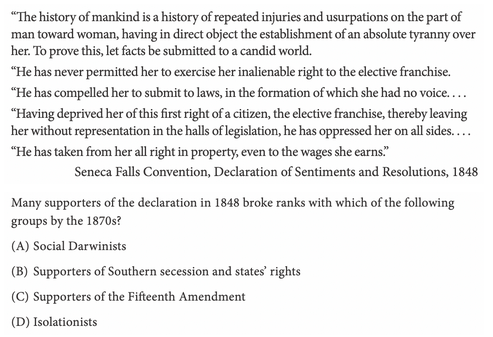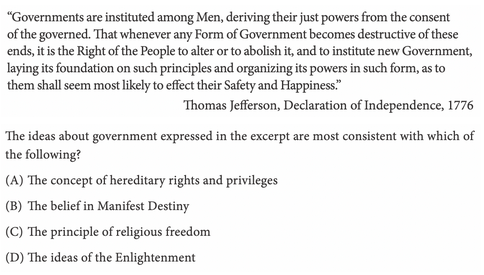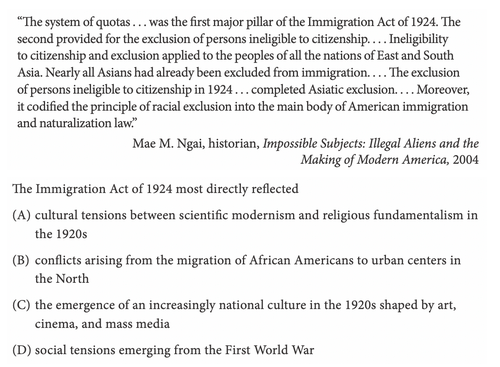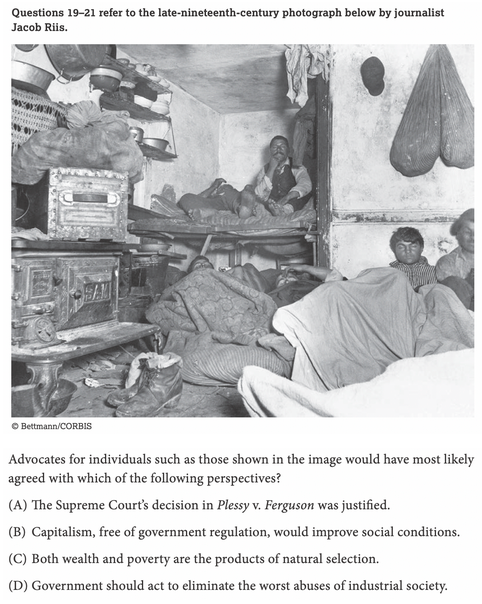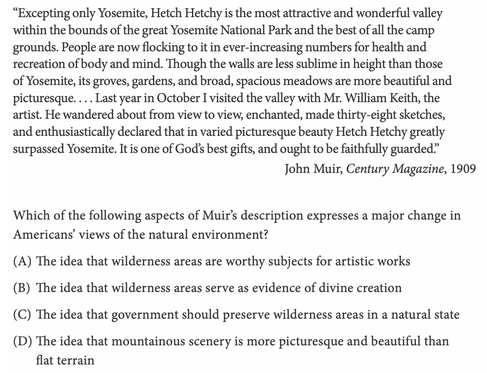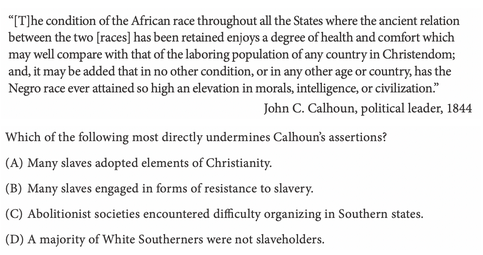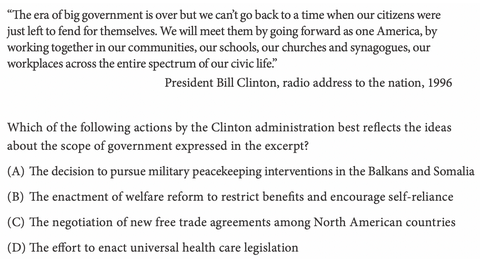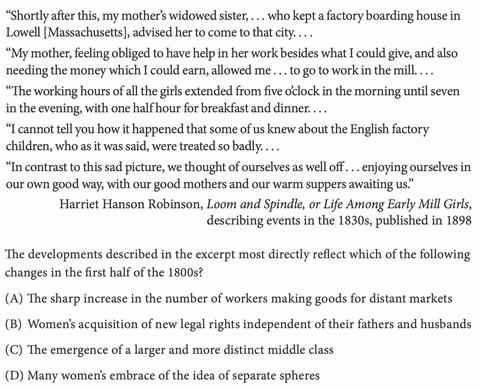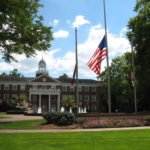10 Hardest AP U.S. History Practice Questions
What’s Covered:
- How Will AP Scores Impact My College Chances?
- Overview of the AP U.S. History Exam
- 10 Hardest AP U.S. History Questions
With only 13% of test takers scoring a 5 in 2020, the AP U.S. History Exam is notorious for its length and difficulty. The test requires you to analyze text and visual information in order to answer corresponding questions—all while under a time crunch. This means you’ll need to learn how to answer these questions quickly and correctly. In this post, we’ll cover some difficult AP U.S. History practice questions (with detailed explanations), along with some tips on how to approach this exam.
How Will AP Scores Impact My College Chances?
When it comes to AP courses, your scores are less important than you may think. The scores themselves are optional, rather than required to report on most applications. Colleges usually look to AP classes as a demonstration of your high school course rigor. If you’re curious, we’ve broken down the impact of your AP scores in college admissions.
Though most colleges don’t take AP scores heavily into account, this doesn’t mean that you shouldn’t try on your AP exams. Some colleges will waive requirements or even give you credit for certain AP scores! This will save you time and money, and might even mean that you can graduate early.
If you’re wondering what your chances are of getting accepted at your dream schools, check out CollegeVine’s free chancing calculator. It takes into account stats like GPA and standardized test scores, along with more holistic factors like extracurricular activities to predict your odds of admission at more than 500 colleges and universities.
Overview of the AP U.S. History Exam
The AP U.S. History Exam will be offered on paper on May 6th and as a digital exam on May 19th and June 2nd.
The paper administration of the AP U.S. History exam consists of two sections:
- Section I:
- Part A: 55 multiple choice questions (55 minutes), 40% of exam score
- Part B: 3 short answer questions (40 minutes), 20% of exam score
- Section II: 1 document-based question and 1 long essay question (1 hour 40 minutes), 40% of exam score
The digital administration of the AP U.S. History exam consists of two sections:
- Section I:
- Part A: 55 multiple choice questions (55 minutes), 40% of exam score
- Part B: 3 short answer questions (40 minutes), 20% of exam score
- Section II: 1 document-based question and 2 short answer questions (1 hour 40 minutes), 40% of exam score
For the paper administration of the exam, students will have options to choose from for one of the short answer questions and for the long essay question. The digital administration of the exam does not give you options. Also, for the digital exam you will not be allowed to go back to a question that you’ve already answered, and you won’t be able to skip ahead either.
Regardless of which exam format you encounter, the exam will expect you to have an in-depth knowledge of the following themes:
- American and National Identity
- Work, Exchange, and Technology
- Geography and the Environment
- Migration and Settlement
- Politics and Power
- America in the World
- American and Regional Culture
- Social Structures
Since all multiple choice questions and most free response questions contain corresponding text, images, charts, or maps, be prepared to analyze the sources and the historical developments and processes embedded within them.

[amp-cta id="9459"]
10 Hardest AP U.S. History Questions
1.
Answer: B
Questions with these types of passages can be difficult, since most of the work entails deciphering the meaning of the passage. We can do this by pinpointing key phrases. In this case, the first few sentences are merely setting up context around the reverend. But, the effect of his sermons can be seen in the sentence “from being thoughtless or indifferent about religion, it seemed as if all the world were growing religious.”
This, taken into account with the backlash from the clergy in the existing churches (who “refused him their pulpits”), shows that choice B is the correct answer, since Whitefield’s open-air preaching meant that individuals were learning new ways of religious thought.
2.
Answer: C
This question details the importance of reading the origins of the passage. Here, the text is from the Declaration of Sentiments and Resolutions from the Seneca Falls Convention. This lets us know that supporters of this declaration were proponents of women’s rights.
So, the correct answer should be C, since the Fifteenth Amendment divided the women’s rights movement. This amendment enfranchised all men, overturning the previous law that only white men could vote. But, some women were unhappy with this amendment, since they felt that women were denied their opportunity to be enfranchised, which split the movement into two groups, those who supported the Fifteenth Amendment and those who didn’t.
3.
Answer: D
For this question, be careful not to let outside knowledge lead you astray. Though the signers of the Declaration of Independence firmly believe in the concept of hereditary rights and privileges and the principle of religious freedom, this excerpt is more consistent with the ideas of the Enlightenment.
This is because the excerpt details that the government derives its powers “from the consent of the governed.” This stems from Enlightenment philosopher John Locke’s theory that a government is only legitimate if the governed consent to its authority, so answer choice D is the best answer.
4.
Answer: D
Though answer choices A, B and C are true statements about what was happening during the 1920s, they don’t directly relate to American immigration policy. So, answer choice D is the correct answer. Americans were becoming increasingly isolationist following World War I, and the government’s response was to impose stricter immigration policies.
5.
Answer: D
Don’t overlook the description above the picture as it provides contextual information. The late 19th century was characterized by a growing divide between the rich and the poor due to industrialization. The individuals inside the picture are likely experiencing poverty as a result of industrialization.
This information makes answer choice B incorrect, since advocates for these individuals would say the opposite: government regulation should be imposed to improve the poor social conditions caused by capitalism. Answer choice C is similarly incorrect since advocates wouldn’t write off these individuals’ situation as the product of natural selection. Instead, they would seek government action to help such individuals. So, choice D is the best answer.
6.
Answer: C
The first thing to note is that John Muir was a prominent environmental philosopher who was known for advocating for forest conservation. This background knowledge allows us to immediately flag choice C as the best answer.
However, even if you aren’t equipped with this prior knowledge, the passage will lead you to the correct answer. Particularly, the phrase that the valley “ought to be faithfully guarded,” indicates that Muir is calling for wildlife preservation.
7.
Answer: C
One of the guiding principles in Washington’s Farewell Address was a neutral foreign policy and he warned the young nation to avoid foreign entanglements. This is apparent in the passage when he states, “foreign influence is one of the most baneful foes of republican government.” Answer choices A and B are incorrect since they involve the United States forming foreign alliances. Also, answer choice D is incorrect since it does not demonstrate a neutral policy. Then, choice C is correct; the United States refusing to join the League of Nations reflects Washington’s desire to have the country avoid foreign influence.
8.
Answer: B
Let’s start by determining the main idea of the text: Calhoun claims that “the condition of the African race throughout all the States” is better in the United States than in any other country, or than it has ever been. Choices A, C, and D all fail to contradict this claim, so they are incorrect.
But, answer choice B is correct since resistance to slavery directly undermines Calhoun’s notion of slaves’ conditions being better than they have ever been.
9.
Answer: B
This question may be misleading, since the radio address taken out of context seems as if Clinton is advocating for more welfare benefits. But, the Clinton Administration actually pushed forward the Welfare Reform Act of 1966, which decreased benefits. This means that answer choice B is the correct answer, and Clinton is encouraging self-reliance in lieu of substantial government intervention.
10.
Answer: A
This passage describes the life of the mill girls, young women who worked in factories during the late 1800s. Choice B is a tempting answer, but is ultimately incorrect. Women did gain independence to some degree by entering the workforce, but their independence was not in the form of legal rights.
So, choice A is the best answer, since the late 1800s industrial revolution was characterized by workers moving from agrarian to industrial contexts.
Final Tips
To wrap up, here are some final tips to guide you as you study for the AP U.S. History Exam.
Focus on the bigger picture
Because the AP U.S. History exam covers a broad range of material, try to focus on honing down key concepts of each era, rather than spending the majority of your time memorizing specific names and dates. Though this information is helpful, especially when constructing essay responses, it’s better to know the broader themes of each era because many questions involve contextualizing or comparing information.
Pay close attention to the supplemental text or images
As we’ve seen from the practice questions, try not to let outside information lead you astray. Outside knowledge will be helpful in certain contexts like if a question is asking you specifically about the meaning within the text or image. However, make sure that your answer is reflective of what the text or image is actually showing you, and not of something that is from your prior knowledge.
As you study for this and other AP exams, check out these helpful articles:


